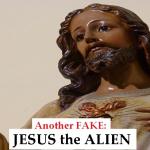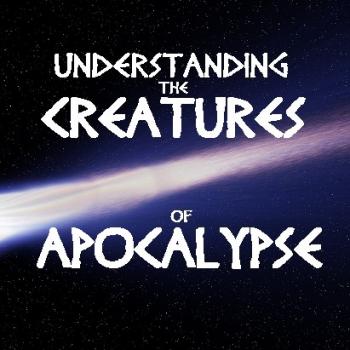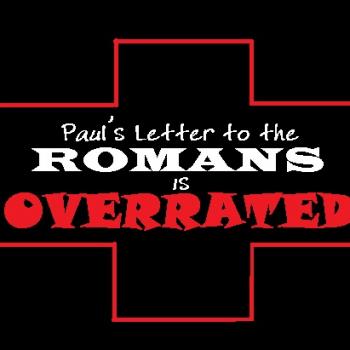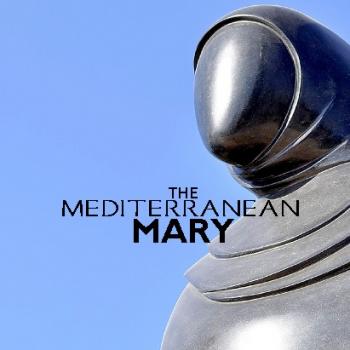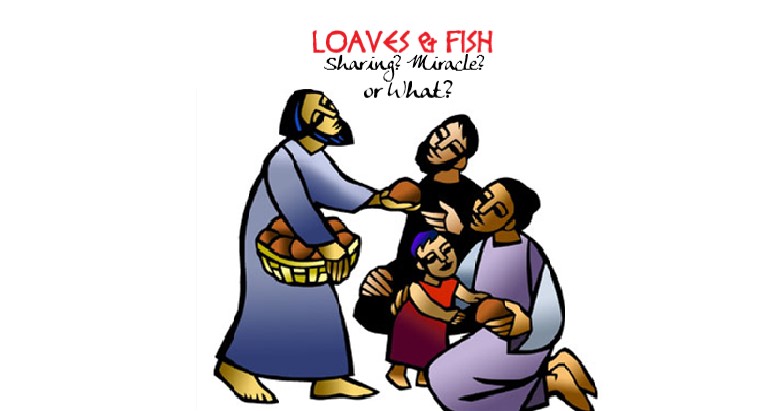
Sorry to U.S. Bible readers, but Jesus’ wonder of multiplying loaves and fish was neither a miracle nor a lesson about sharing.
Here comes another Sunday of horrible homilies. It begins with the Gospel reading, another version of Jesus feeding a multitude (John 6:1-15). The story of Jesus feeding a crowd of Israelites is found in all four canonical Gospels (Mark 6:32-44 // Matthew 14:13-21 // Luke 9:10-17).
Sharing the Origins of this Sunday’s Gospel
Scholars, therefore, debate its origins. Does this multiply attested story indicate that “John” was familiar with the Synoptics? Did the original tradition draw from the old story where Elisha fed a crowd (2 Kings 4:42-44)? Was this story colored by the early Eucharistic sharing in first-century Jesus groups?
It’s unlikely, for several reasons, that the community that finished editing the document called “John” knew about “Mark,” “Q,” “Matthew,” or “Luke.” He probably worked off of an independent tradition. Before this story was written down, it is more probable that an oral tradition of it evolved in retellings and was linked to the wondrous feeding of Elisha. It is even more likely that the ritual meal practices of early Jesus groups colored these Gospel accounts.
Although this story is found in both “Mark” (an original source) and “John” (an original source), they present the marvel quite differently. In “Mark,” it is the disciples who serve the crowd. But in “John,” Jesus himself serves the food (not unlike how he does so in the Synoptic “Last Supper” accounts). The Markan Jesus and the Johannine Jesus are very different! In the Fourth Gospel, Jesus is always in control and takes the initiative (John 6:5).
A Miracle of Loaves?
Today, preachers will say word miracle frequently. Homilists will affirm that this feeding is another great miracle of Jesus. This is unfortunate, however, because there is no warrant to use that term for this story. In fact, there is no justification in ever using that word miracle for any other Bible story!
Contrary to popular and spurious opinions, no one sought out any miracle from Jesus. No one who ever met Jesus, or went to Jesus for healing, was looking for a miracle. Nobody asked Jesus for a miracle. Why? It is because Jesus and his contemporaries lived centuries before the Enlightenment.
“Miracle” is a nice post-Enlightenment word—a violation of the physical laws governing the universe. Since no one in the first century, including Jesus, could conceive of physical laws governing the universe, how could anyone, Jesus included, imagine violations of those laws? They couldn’t. Hence Jesus was not a miracle-maker.
As presented in the Gospels, God worked marvels and wonders (not miracles) through Jesus, yes. Unlike the Synoptics, in the Gospel called “John,” the works of God in Jesus are called “signs.” But there is no miracle to be found anywhere in these documents.
Sharing Western Problems
Did it happen? It certainly could have but in Alternate Reality. And it indeed did for the later Jesus groups when they came together and went into a trance at their ritual meals. By the way, “Alternate Reality” doesn’t mean “benign hallucination” or “pathological delusion.” Alternate Reality is very real; just as actual as the “culturally-ordinary” reality we Westerners would like to imagine is the only “real world.”
Two realities make up the cosmos. First, the so-called “ordinary” reality (accessed via pragmatic consciousness), in which we function in society. And second, Alternate Reality, where the deceased are together with God and the other spirits. Both are very real, and events transpiring in either are likewise real. All human beings can experience over thirty-five different states of consciousness whereby we can find access to either aspect of the Total Real.
Walking on the Sea (Mark 6:45-51) is not a miracle but a mighty deed performed in Alternate Reality. When Peter and the disciples meet Jesus walking on the Sea (demon), they undergo a trance experience. In other words, they have entered Alternate Reality, where shamanic figures walk on the Sea (demon). This is not fake or fantasy, but something genuinely real. However, it does not happen in ordinary reality but in Alternate Reality.
Why does Peter sink (Matthew 14:30)? It is because his consciousness reverted back to ordinary reality. This is also an authentic experience of something that really happened.
Really Real Realities
Haven’t you ever talked in your sleep? For you, experiencing your alternate state of consciousness (i.e., dreaming) makes sense. You are perfectly intelligible to all those in Alternate Reality. But anyone hearing you in ordinary reality, your speech is confused and unintelligible.
And we experience departed loved ones in our dreams, and this also is very real. These experiences in Alternate Reality impact and influence our culturally ordinary reality.
So enlightened by the social sciences and cognitive neuroscience, what we wrongly call a “miracle” in Scripture is really an alternate state of consciousness experience. Upon falling into a trance, human beings are capable of transitioning to Alternate Reality, whether the sky-vault (e.g., 2 Corinthians 12:2, 4; Revelation 4:1-2), or the underworld (e.g., 1 Samuel 28:8-20), or somewhere else (e.g., Ezekiel 8:3; Acts 8:38).
Sharing About Western Misunderstandings
Contemporary, scientifically-minded, rationalist Americans block ASC experiences unless they are drinking, drugged, or sleeping (i.e., lacking control). Thus unfamiliar with and culturally crippled to these panhuman experiences, many American believers remain skeptical about Jesus multiplying loaves. So they ethnocentrically read the story, looking for a plausible “take-away.” Therefore, in American embarrassment, they transform the story into a fable about sharing. Ultimately, the true miracle is Jesus getting this crowd to share their food.
This is nonsense, folks. It would indeed be unbelievably marvelous for an entitled and greedy throng of American individualists to share in this way. But the Mediterranean crowd in the Gospel story would have no problems sharing food. Biblical peasants always shared food! Why would Jesus need to teach his people a lesson everyone knew?
What the Gospel Story Is About
The crowd in the Gospel story were starving peasants. They had no provisions. Ultimately, this is neither a miracle story nor a fable about sharing. What is it about then?
For “John,” everything is about embedding emotionally into the Johannine Jesus group. So this story also is about the Johannine community and the reality they share. Evangelists did not write his story wasn’t written for American fundamentalists to prove their belief in Jesus as God because he can override the laws of nature (via a miracle). They also did not write it for other Americans to get a message about the goodness of sharing. “John” was not written by, for, or about Americans.
Instead, the Johannine Jesus group wrote the Fourth Gospel, for the Johannine Jesus group, about the Johannine Jesus group. It’s about what they already share in the endless descents of Jesus, the Sky-Vault Man, in their group-ASC experiences. And suppose American Christians desire to derive a real spiritual meaning for us? In that case, this literal meaning is that foundation on which we must build.

